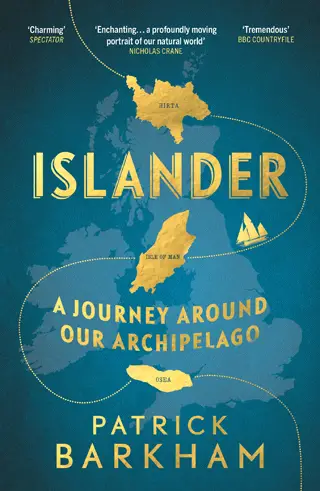Islander by Patrick Barkham – Review

By David Schuster
Islander is a beautiful, lyrical Tardis-like book. On the face of it, it is a travelogue of the author’s visits to eleven of the outlying British Isles. However, within its relatively modest 350 pages it crams the social, political and natural history of these islands alongside a host of witty observations.
It even manages to provide a brief biography of Compton Mackenzie, who disastrously owned a number of islands before finding his muse on Barra and writing Whisky Galore, his best-selling fictionalisation of a real-life shipwreck on that island. The same Compton Mackenzie whose autobiography ran to ten volumes! It does all this in such an easy-to-read, friendly manner that you almost feel that you are taking an informative walk across the islands with the author.
“Engaging”
 Barkham starts with the Isle of Man, tackling both its distant past of myth and legend, and its modern incarnation as a tax haven in an equally engaging manner. Amongst the other islands covered are the contrasting Isle of Eigg, owned in community trust by the residents of the island, and St Mary’s in the Isles of Scilly, the majority of which is still owned by the Duke of Cornwall, Prince Charles. Each island he visits, making an exception for St Kilda, is progressively smaller than the last. His journey finishes with an overnight camp on Ray Island, off Essex, which covers just 110 acres and has no permanent residents.
Barkham starts with the Isle of Man, tackling both its distant past of myth and legend, and its modern incarnation as a tax haven in an equally engaging manner. Amongst the other islands covered are the contrasting Isle of Eigg, owned in community trust by the residents of the island, and St Mary’s in the Isles of Scilly, the majority of which is still owned by the Duke of Cornwall, Prince Charles. Each island he visits, making an exception for St Kilda, is progressively smaller than the last. His journey finishes with an overnight camp on Ray Island, off Essex, which covers just 110 acres and has no permanent residents.
In a way reminiscent of Robert Macfarlane’s The Old Ways, the author artfully constructs poetic paragraphs which avoid being florid: ‘Great slabs of granite slope away to meet a treacherous looking tidal current. The rocks are fringed with kelp swishing back and forth, deliberately, like the tail of an angry cat’.
“Quirky facts”
Islander provides much food for thought. I did not know for example that during the second world war the island of Alderney was the site of SS Lager Sylt. Built by the Nazis using slave labour, it was the only concentration camp to be built on British soil. It also highlights that island ecologies are fragile as the endemic species have nowhere to go. By carving up the wild places and confining rare animals to national parks, we have effectively created land-locked ‘islands’ where the continued existence of those animals will always hang in the balance.
As well as the serious messages, the text is packed with pub-quiz friendly snippets, such as Barra airport being the only one in the world where scheduled flights use a beach as the runway, and ‘nesomane’, the term for a person who loves islands. It also contains many quirky facts – I’d not heard of the metre-high pygmy elephant that inhabited some Mediterranean islands in prehistoric times.
Barkham has travelled extensively and that shows in the breadth of the storytelling in Islander. I learned a lot from this delightful book about those islands which I have been to in the past and discovered some more which I now want to visit. Be warned; by the time you finish reading, you too may be a nesomane.
‘Islander – A Journey Around Our Archipelago’ by Patrick Barkham is published by Granta Books, £20 hardback







